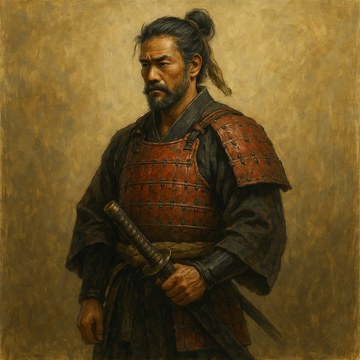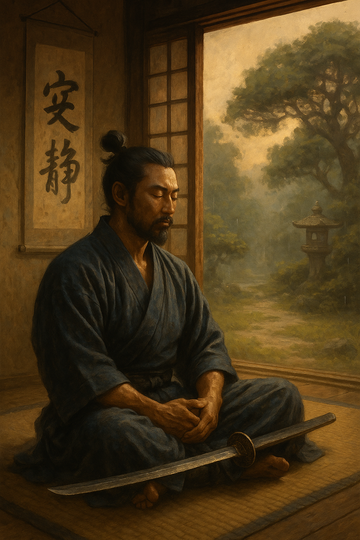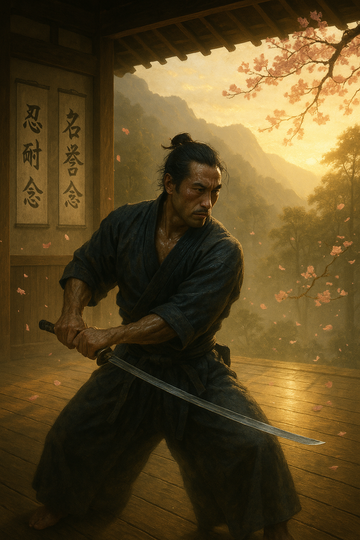The Samurai’s Guide to Self-Discipline: Cultivate Inner Strength
Few figures from history capture the imagination quite like the samurai, with Miyamoto Musashi being one of the most iconic among them. These warriors have come to symbolize honor, resilience, and, perhaps most of all, self-discipline. Their lives were shaped by strict codes of conduct, rigorous routines, and a relentless commitment to personal growth, driven by inner strength. While the swords they carried and the battles they fought are legendary, it's the internal battles—the patient honing of spirit and will—that hold the most enduring lessons.
So, what did the samurai understand about self-discipline that still holds power today? How can their insights transform the way we manage our habits, pursue our goals, and shape the quality of our lives?
The Code That Shaped Warriors: Bushido
Samurai conduct was bound by Bushido, often called the "Way of the Warrior." This code was more than a set of rules; it shaped their thinking, choices, and responses to hardship. At the center of Bushido sat self-discipline—not just as a virtue, but as a foundation for every action.
Bushido's principles included:
- Rectitude (Gi): Making ethical choices, even when inconvenient.
- Courage (Yu): Acting boldly, despite fear.
- Benevolence (Jin): Showing compassion and kindness.
- Respect (Rei): Demonstrating humility and courtesy.
- Honesty (Makoto): Telling the truth and staying true to one’s word.
- Honor (Meiyo): Upholding personal and family reputation by living with integrity.
- Loyalty (Chu): Remaining steadfast to one's commitments.
Each of these values requires discipline. Whether resisting the urge to act rashly, pushing through discomfort, or sticking to a promise, self-control was seen as the true mark of a warrior.
Daily Rituals: Building Habits with Intention
Modern psychology confirms what samurai already practiced centuries ago: discipline thrives on routine. Samurai didn’t rely on fleeting bursts of motivation; they crafted their days around intentional actions that became second nature.
Their day typically started well before sunrise. Meditation, calisthenics, martial arts drills, study of philosophy, and mindful weapon care filled the morning. These rituals weren’t simply about preparing for battle—they were about taming the mind, sharpening focus, and fortifying character.
Consider how these routines manifest today:
|
Samurai Practice |
Modern Equivalent |
|---|---|
|
Dawn meditation |
Mindfulness, morning gratitude |
|
Weapons upkeep |
Organizational habits, planning |
|
Kata (form practice) |
Skills rehearsal, daily exercise |
|
Poetry and calligraphy |
Creative pursuits, journaling |
Committing to a thoughtfully structured routine builds reliability—not only in the hands, but in the heart.
Mastery Over Impulse
Self-discipline often breaks down when impulse takes over. Whether it’s the urge to procrastinate, react in anger, or indulge in distraction, these moments test the boundary between purpose and desire.
The samurai engaged in rigorous training of their minds alongside their bodies. Meditation was a daily staple, not for relaxation, but for mastering the inner dialogues that so often lead to self-sabotage. Techniques like ‘mushin’—the “mind without disturbance”—promoted mental clarity and clear-headed action in the face of stress or danger.
These lessons can be applied far beyond the dojo or battlefield. Keeping cool during business negotiations, resisting the lure of social media, or sticking to healthy eating are modern settings for practicing that same composure. Real discipline is often quiet, revealed not in dramatic acts but in the persistent, unseen choices of daily life.
Endurance in Face of Hardship
Every samurai faced pain, defeat, and disappointment. Despite the myth that discipline is a sign of unwavering strength, even the greatest warriors struggled at times. What made their discipline resilient was how they handled adversity.
They embraced the idea of “kaizen”—continuous improvement. Even masters recognized their flaws and setbacks as stepping stones rather than roadblocks. When discipline faltered, the focus was not on shame, but on recalibration and forward motion.
This attitude suggests a more compassionate form of discipline, one that recognizes lapses as human and places value on getting back on track.
The Power of Purpose
What separates fleeting self-control from lasting discipline? The samurai answer lies in having a strong sense of purpose.
A samurai lived to serve—whether it was a lord, an ideal, or a code. This sense of meaning gave context to their sacrifices. When faced with comfort or convenience, recalling that greater mission helped reframe the small daily choices as part of a larger story.
Research on willpower echoes this wisdom: those who understand why they act are far more likely to stay disciplined. Finding your own “why”—be it family, art, social impact, or personal excellence—can act as a compass on the hardest days.
Here are a few questions to help crystallize a sense of purpose:
- What values do I want to express in my actions?
- Who benefits from my discipline?
- What long-term vision excites or inspires me?
- In what areas am I willing to be uncomfortable for something bigger?
The Discipline of Letting Go
It’s easy to think of discipline as mere rigidity—strict rules and self-denial. Yet, the tradition and history of the samurai offer a different perspective.
They valued adaptability and recognized the wisdom in yielding to changing circumstances. Sometimes, this meant surrendering pride, adjusting tactics, or releasing what no longer served the greater mission.
Practicing discipline, then, is not about blind stubbornness. It's knowing when perseverance matters, and when flexibility—or even retreat—is the wiser course. Letting go is itself an act of mastery, requiring both courage and humility.
Integrity When No One is Watching
Much of samurai discipline had to do with private moments—the choices made without any audience or applause. Upholding honor, practicing honesty, or staying loyal meant little if performed only for recognition.
Modern readers can take this as a reminder to focus on personal integrity. Whether pursuing fitness, writing, study, or simply striving to be a kinder presence, the most meaningful gains come during those instants when no one else is watching.
Finding Balance in All Things
One of the most striking aspects of samurai life was how it balanced intensity and calm. Study, poetry, and tea ceremony existed alongside swordsmanship and strategy. This wasn’t just a quirky hobby; it was a philosophy.
Creative work and mindful living helped prevent burnout and nurtured emotional resilience. These pursuits offered renewal and provided reminders that discipline is ultimately a means to live more completely—not just to accomplish more.
Here’s a look at how this cultured approach unfolded:
|
Martial Pursuit |
Artistic/Cultural Pursuit |
|---|---|
|
Archery (Kyudo) |
Calligraphy (Shodo) |
|
Swordsmanship (Kenjutsu) |
Tea Ceremony (Chado) |
|
Strategy Study |
Poetry (Haiku) |
|
Physical Conditioning |
Painting, Music |
Modern life, with its relentless pace and technological distractions, often tempts us to treat rest and creativity as luxuries. The samurai path suggests otherwise: balance is part of mastery.
Translating Samurai Wisdom Into Modern Practice
Adapting centuries-old wisdom might seem daunting, but the practical steps are surprisingly accessible:
- Craft a daily routine that includes time for mind, body, and spirit.
- Identify core values and let them guide decisions.
- Practice mindfulness to observe, not react to, impulses.
- Treat setbacks as learning opportunities, not failures.
- Seek balance through both striving and stillness.
- Do the right thing, even when invisible to others.
Perhaps the greatest lesson is this: discipline is less about force, and more about alignment—bringing one’s actions, intentions, and values into a cohesive, authentic pattern.
The samurai may have lived in another time and place, but their quietly fierce commitment to self-mastery still points the way for those who seek to direct their own lives with courage, clarity, and purpose.





